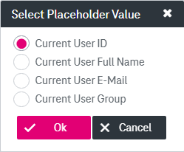Date search
To define date values (e.g. Creation Date), use the date/time picker (see chapter Date / time pickers for details).
Multi-value search
Click the three dots located to the right of a search field and select Add Value (see Advanced options for search fields). In this way, more fields can be opened to specify multiple values. The search then returns all results with hits matching any one of the search terms.
In the following example the search is extended to return hits containing “Smitt” or “Westermann”:


Figure 870: Multi-value search fields
To delete fields for multiple values click the button Remove Value (see Advanced options for search fields).
Alternatively, you can paste multiple values (e.g. separated values copied from the Excel file) in the search field. The extra lines will be added automatically for each separate value.
The multi-value search is available for all attribute types except for logical values (“true” or “false”). It extends the search by a logical disjunction where search terms are combined with the operator “OR”, so at least one value must match to produce a hit.
Independent of the multi-value search there is also an administrative setting called “multi-value attribute” for storing several values in one attribute. If a search field targets such a multi-value attribute, the search value will be compared with all single values for this attribute, and the result will be rated as hit as soon as one value matches.
Range search
Click the three dots located to the right of a search field, and activate the box Use Range to open an additional field for specifying a range for searching. The given search terms in the two fields will then serve as lower and upper bound for an alphanumeric range search.
The result of a range search always includes elements matching the lower and upper bound. Range searches are supported for date and number based field types.


Figure 871: Range search fields
A range search for a number attribute value does not accept usage of number operators (see Numeric values search). The search always uses the range including the boundaries.
Use placeholder
Placeholders can be used in search queries where e.g. the user or the current group is stored in an attribute. Click the three dots located to the right of a search field, and select Use Placeholder. Select one of the possible options depending on the attribute type. The following options are available:
-
string attributes: information for the current user:

Figure 872: Placeholder dialog window for string attribute
-
date/dateTime attributes: the current date/dateTime
Additionally it is possible to manipulate the date based on the current date, e.g. “now plus 7 days” or “now plus 10 months” by activating the option Manipulate Date and entering number values with “plus” / “minus” symbols:

Figure 873: Placeholder dialog window for date/dateTime attribute
If the placeholder is set, the respective value is displayed in the disabled input field (e.g. “Current User ID”, “Current User Group”, “Now plus 7 days”).
To edit or delete placeholders, click the three dots located to the right of a search field, and select the option Edit Placeholder. Edit the placeholder in the dialog or click the button Remove.
The placeholders can also be used in search bookmarks.
Use NOT operator
Click the three dots located to the right of a search field, and activate the box Use NOT Operator to define a search query that internally applies a NOT operator, which only returns results that do not contain the specified entry.

Figure 874: Search field with operator “not”
Empty value search
Click the three dots located to the right of a search field, and activate the box Search for Empty Values to define that the search results shall also include items with empty values in this field. If the option is selected, the corresponding input field is disabled.

Figure 875: Empty value search field
For numerical values you can use comparison operators:
-
= (equals), which is the default
-
>, >= (greater than, greater or equals)
-
<, <= (less than, less or equals)